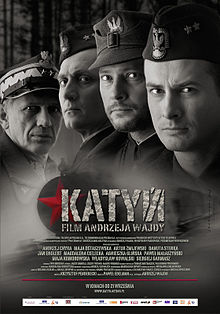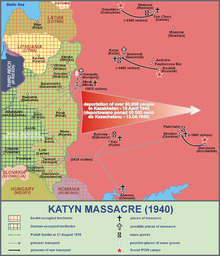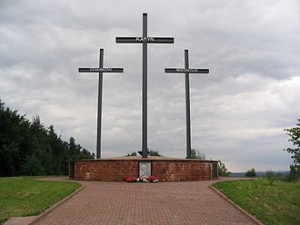 If I were to be asked right now to choose only one movie among the movies I’ve seen that is the most worthwhile, I would choose the Polish movie Katyń without hesitation. It is quite a high quality movie and this movie offers information that I may never have known if I hadn’t watched it. I am grateful for this movie from the bottom of my heart.
If I were to be asked right now to choose only one movie among the movies I’ve seen that is the most worthwhile, I would choose the Polish movie Katyń without hesitation. It is quite a high quality movie and this movie offers information that I may never have known if I hadn’t watched it. I am grateful for this movie from the bottom of my heart.
Sandwiched between Russia on the east side and Germany on the west, Poland has tragically been the victim of the two countries’ power struggles throughout history. In September of 1939, Germany invaded Poland, beginning World War II, and, utilizing this chaos, the Soviet Army invaded Poland from the east. While this was going on, the Nazi-Soviet non-aggression treaty was covertly signed and Poland was occupied and divided by Germany and the Soviet Army. Poles being pursued by from the German army from the west and Poles being pursued by the Soviet Army from the east encountered each other near the Bug River in eastern Poland. Those escaping from the Soviet Army told the Poles who escaped from Germany that it was dangerous and to head back west, while those escaping from the German army said the opposite. At that moment, trapped between two armies, each individual had to decide their fate.
The Polish government escaped to London and formed a Polish government-in-exile. Polish soldiers immediately complied with the orders of both armies, honorably and peacefully surrendering to the German and Soviet armies. The German army, in accordance to international law, released their Polish soldiers, but the Soviet Army did not. Katyń depicts the fates that followed the Polish soldiers that surrendered to the Soviet Army.
After the Soviet-German War broke out in 1941, the Polish government-in-exile and the Soviet Union formed a treaty with an anti-German interest, and the Soviet Union was supposed to release all of their Polish prisoners and organize a Polish unit to attack the Nazis. However, more than 90% of the soldiers that were prisoners were unaccounted for; when the Polish government-in-exile in London pursued the Soviet Union to release all of the Polish soldiers, the Soviet Union responded that there was delay due to office work and transportation.
 However, the German army violated the non-aggression treaty and invaded Soviet Union territory in April 1943; near the Katyn forest, former Soviet Union territory, they discovered the dead bodies of nearly twenty thousand Polish soldiers. Germany widely broadcasted this crime committed by the Soviet Army in 1940. After Germany was defeated and World War II ended in 1945, Poland was put under Soviet Union control as a satellite country of the Soviet Union. The Soviet Union argued that, in fact, the Katyn forest massacre was an act of the German army and they carried out a grand anti-Nazi campaign; afterwards, it became taboo for Poles under Soviet Union control to mention the truth of the event.
However, the German army violated the non-aggression treaty and invaded Soviet Union territory in April 1943; near the Katyn forest, former Soviet Union territory, they discovered the dead bodies of nearly twenty thousand Polish soldiers. Germany widely broadcasted this crime committed by the Soviet Army in 1940. After Germany was defeated and World War II ended in 1945, Poland was put under Soviet Union control as a satellite country of the Soviet Union. The Soviet Union argued that, in fact, the Katyn forest massacre was an act of the German army and they carried out a grand anti-Nazi campaign; afterwards, it became taboo for Poles under Soviet Union control to mention the truth of the event.
This movie depicts the tragedy of the few families of the Katyn massacre victims that resisted the occupying Soviet Union by trying to reveal the truth of the event—after the Soviet rule started, most Poles obeyed the Soviet Union because of their hatred of Nazi Germany and for the sake of their personal safety.
Director Andrzej Wajda’s father was killed in the Katyn forest massacre. He gained international fame with works such as Kanał, Ashes and Diamonds, and Man of Marble, but because of his anti-Soviet stance, he was oppressed by the government of Poland. For over 50 long years, he had a plan to make a movie of the Katyn forest massacre, but it was impossible before the collapse of the Berlin Wall; he was already 80 years old when he was finally able to make the movie in 2007. I felt through this movie his determination of, “I can’t die until I convey what happened in the Katyn forest.” We must remember the following three points from this movie.
One, the crime. War is an abnormal, extreme situation where people kill each other, but there are universal rules in it. First, civilians must never be killed intentionally. And even soldiers must be treated humanely once they have surrendered. However, under the orders of Stalin, the People’s Commissariat for Internal Affairs (NKVD) in charge of prisoner accommodations interrogated each Polish soldier, and any soldier that was thought to have even a trace of anti-communist belief was killed mercilessly.
Two, the lie. After Germany discovered the dead bodies near the Katyn forest, Geneva’s International Committee of the Red Cross was asked to conduct a neutral investigation, but, faced with resistance from the Soviet Union, the International Committee of the Red Cross abandoned dispatching the commission. On April 24, 1943, the Soviet Union demanded that the Polish government-in-exile, in alliance with the Soviet Union at the time, announce, “The Katyn massacre was a German scheme.” But the Polish government-in-exile refused and, in response, the Soviet Union cut off their alliance with the government-in-exile. Believing that support from the Soviet Union on the side of the Allies was needed to win World War II, direct criticism of the Soviet Union was not permitted. In 1944, American President Franklin Roosevelt appointed Navy Commander George Earle as a secret agent to gather information on the Katyn forest massacre. Earle collected information by contacting Bulgaria and Romania who were sided with the Axis and came to think that the Katyn forest massacre was an act of the Soviet Union, but Roosevelt rejected this conclusion and ordered for Earle’s report to be suppressed. Earle requested permission to release his investigation, but Roosevelt sent him a written order prohibiting him. Earle was dismissed from these duties after that and he was demoted to duties concerning Samoa. Supported by circumstances from ally countries like this, the Soviet Union was allowed to maintain the lie that Nazi Germany was responsible for the massacre for over 50 years.
Finally, I want to emphasize the arrogance of a nation that wins in war.
The crimes of Nazi Germany were judged in the Nuremberg Trials in 1946. The Soviet Union took advantage of the opportunity as a victor to accuse particular Germans as the masterminds of the Katyn forest massacre, but America and the United Kingdom drew the line at this and refused the accusation of the Soviet Union. After that, an argument on the responsibility of this event continued in both the Western Bloc and Eastern Bloc, but nobody in Poland was permitted to investigate the truth out of fear of the Soviet Union which controlled Poland then. This situation of not asking for the truth continued until the communist regime collapsed in Poland in 1989 and the young generation knew nothing of the Katyn forest massacre.
 After the Soviet Union became less oppressive in 1989, the human rights of the victims of the Katyn forest massacre were finally recognized. In 1989, scholars in the Soviet Union disclosed that Stalin gave the order for the killings and Beria, the chief of the People’s Commissariat for Internal Affairs, signed the decree for the Katyn forest massacre. In 1990, Gorbachev admitted the Soviet Union’s People’s Commissariat for Internal Affairs involvement in the killing of Polish people including in Mednoe and Pyatikhatki, where burial sites like Katyn were found. After the Soviet Union’s collapse in 1992, the Russian government finally released the official documents on the Katyn forest massacre, publicly revealing for the first time in over 50 years the lie that the Soviet Union had maintained.
After the Soviet Union became less oppressive in 1989, the human rights of the victims of the Katyn forest massacre were finally recognized. In 1989, scholars in the Soviet Union disclosed that Stalin gave the order for the killings and Beria, the chief of the People’s Commissariat for Internal Affairs, signed the decree for the Katyn forest massacre. In 1990, Gorbachev admitted the Soviet Union’s People’s Commissariat for Internal Affairs involvement in the killing of Polish people including in Mednoe and Pyatikhatki, where burial sites like Katyn were found. After the Soviet Union’s collapse in 1992, the Russian government finally released the official documents on the Katyn forest massacre, publicly revealing for the first time in over 50 years the lie that the Soviet Union had maintained.
